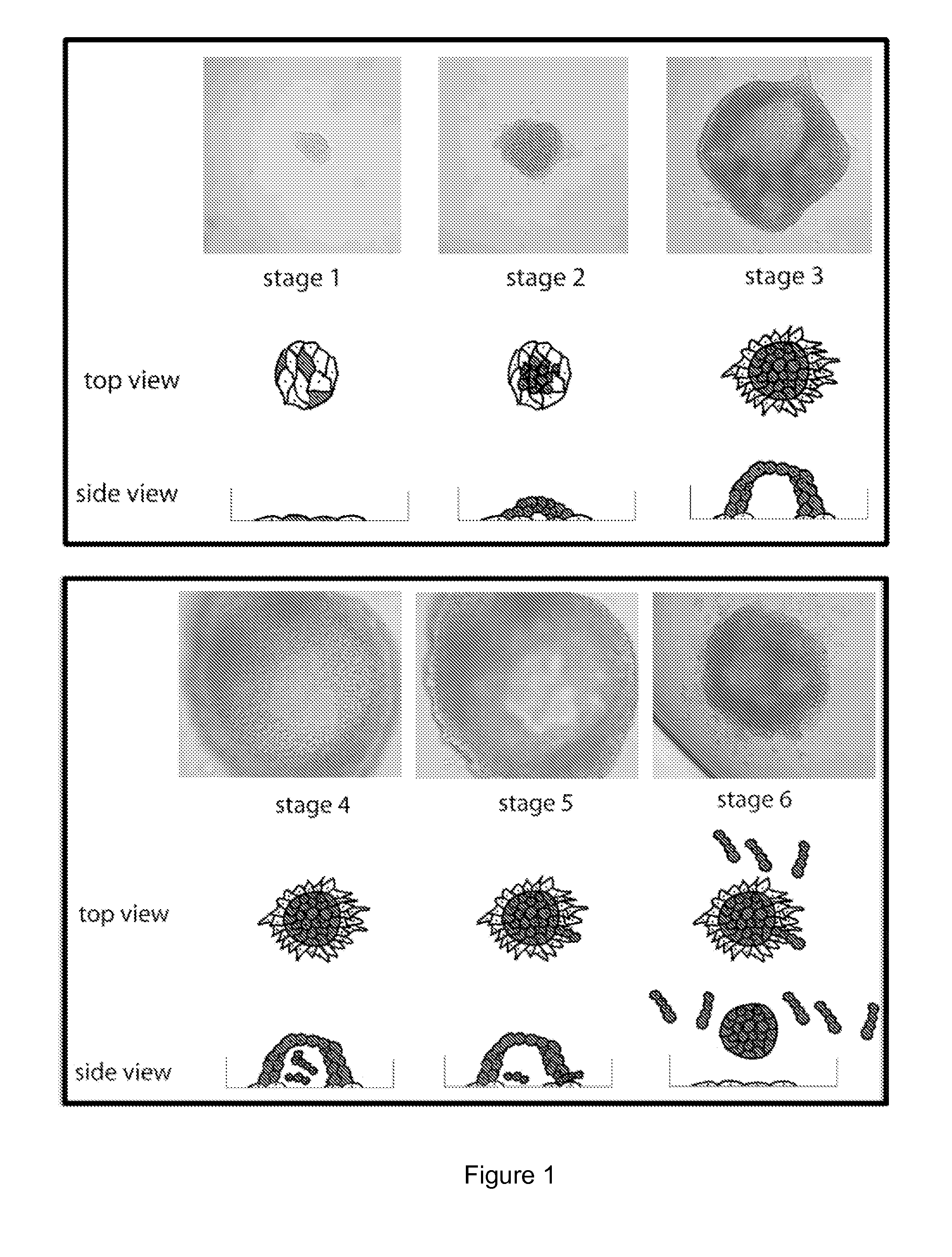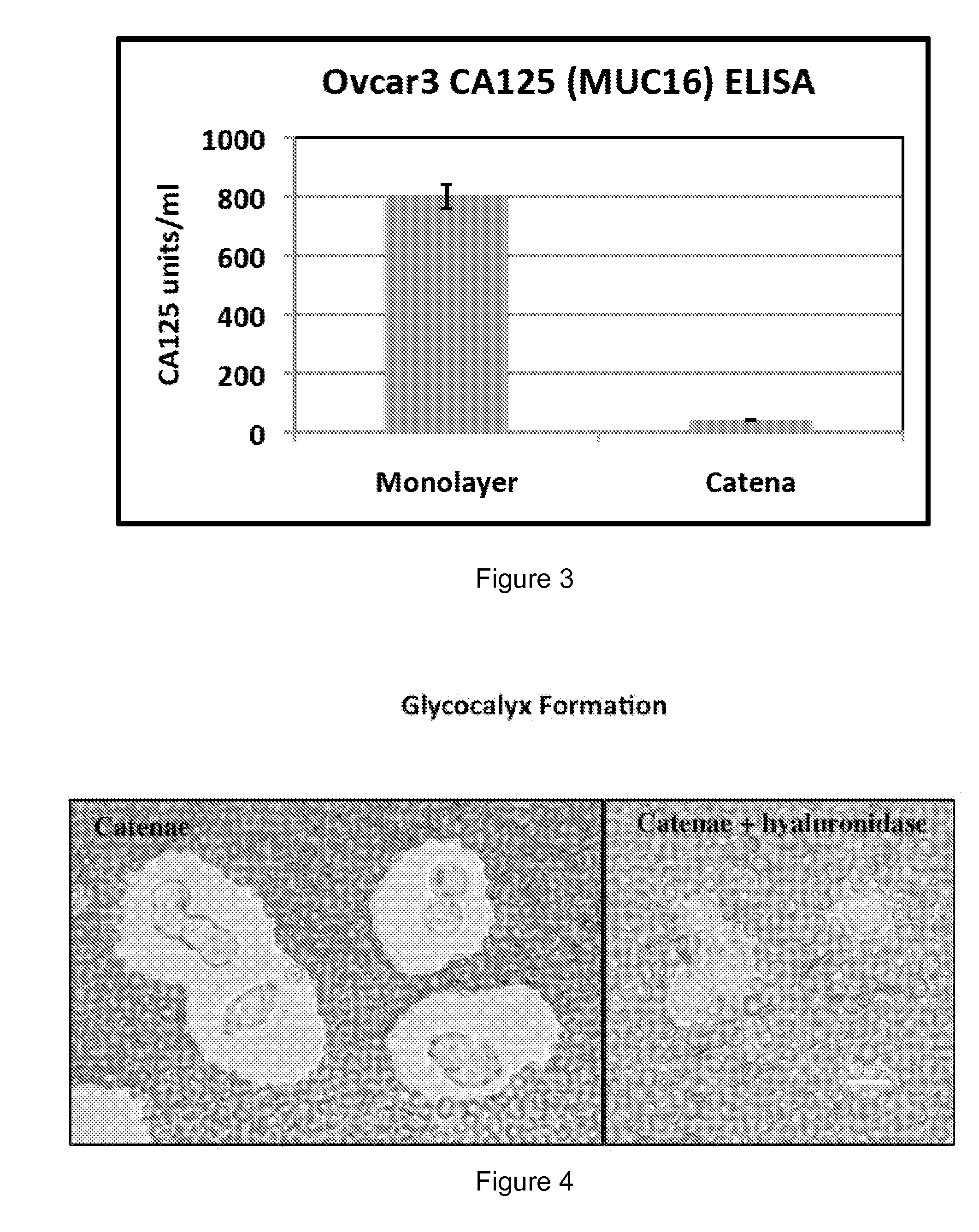Methods of Treating Serosal Cancer
a serosal cancer and cancer technology, applied in the field of serosal cancer treatment methods, can solve the problems of limited csc assays in vitro, mesenchymal, endothelial, etc., and achieve the effects of improving patient quality of life, increasing patient survival time, and increasing in vivo half li
- Summary
- Abstract
- Description
- Claims
- Application Information
AI Technical Summary
Benefits of technology
Problems solved by technology
Method used
Image
Examples
example 1
Catena and Spheroid Formation from Cancer Patient Ascites
1. Catena Formation
[0137]Serosal cancer samples from pleural, pericardial or ascites fluids containing tumor cells were obtained from cancer patients with metastatic cancer. Tumor cells were harvested by centrifugation at 1200 rpm for 10 min. The serosal fluid was removed and stored at −20° C. The harvested tumor cells were put into tissue culture flasks with serosal fluid from the same patient mixed 1:1 with serum-containing media. Free-floating chains of tumor cells were immediately observable under the microscope. The chains remained in suspension for many weeks. The tumor cells were cultured at 37° C. for several weeks and each week, the free-floating chains of cells in suspension were separated from the attached cells and replated into a new flask with the same combination of serosal fluid and serum-containing media. In these studies, as few as 100 of these free-floating cells from primary serosal tumor samples were able ...
example 2
Screening Catenae for Drug Sensitivity
1. Methods
[0139]Ovcar3-GTL-derived catenae were tested for their ability to self-propagate in flat bottom 384-well microtiter plates (Corning). Cultures of Ovcar3-GTL catenae were mechanically or enzymatically dissociated to single cells. For mechanical dissociation, catena cultures were pipetted vigorously, an equal volume of M5-FCS media was added to decrease the viscosity, and the cells were pelleted. For enzymatic dissociation, catena cultures were incubated at 5 mg / ml collagenase IV (Invitrogen) for 10 min at 37° C. followed by centrifugation to pellet the cells. Cells were resuspended in M5-FCS to produce homogenous cultures of single cells which were seeded in 50 μL aliquots per well at the indicated cell densities and grown for the indicated times before addition of test compounds or other reagents.
[0140]To assess cell growth, cells were observed under the microscope and manually counted using a hemocytometer or were treated with alamarB...
example 3
Glycocalyx Analysis
[0157]The catena and spheroid cultures became increasingly viscous at high cell density. Without passage, the catena cultures became so viscous that harvesting the suspension cells was difficult even after a long incubation with collagenase-IV and / or strenuous mechanical dissociation, suggesting that the presence of a glycocalyx coat around the catenae and spheroids was generating the viscous (or mucinous) media. The cells and culture media were examined for the presence of mucins and hyaluronan.
[0158]Initial FACS analysis for the mucin CA125 (the protein product of the MUC16 gene), a biomarker for different types of cancer, indicated that CA125 was not expressed on the surface of catenae. Likewise, ELISA experiments showed that CA125 was not secreted by catenae (FIG. 3). In contrast, Ovcar3-GTL epithelial cells were 98% positive for CA125 by FACS and secreted 800 units / ml of CA125 into culture media. For the ELISA, cell supernatants were collected by spinning the...
PUM
| Property | Measurement | Unit |
|---|---|---|
| time | aaaaa | aaaaa |
| time | aaaaa | aaaaa |
| sizes | aaaaa | aaaaa |
Abstract
Description
Claims
Application Information
 Login to View More
Login to View More - R&D
- Intellectual Property
- Life Sciences
- Materials
- Tech Scout
- Unparalleled Data Quality
- Higher Quality Content
- 60% Fewer Hallucinations
Browse by: Latest US Patents, China's latest patents, Technical Efficacy Thesaurus, Application Domain, Technology Topic, Popular Technical Reports.
© 2025 PatSnap. All rights reserved.Legal|Privacy policy|Modern Slavery Act Transparency Statement|Sitemap|About US| Contact US: help@patsnap.com



